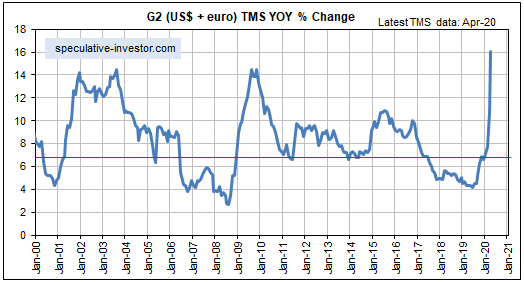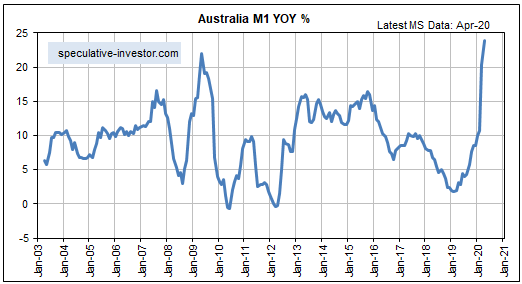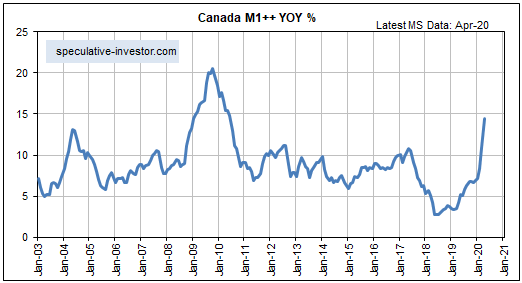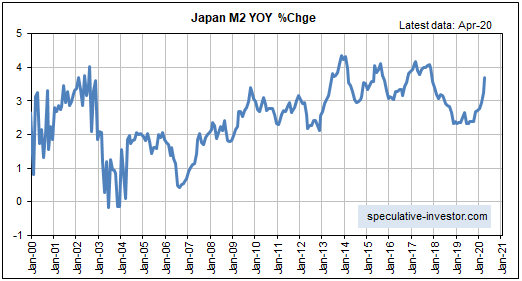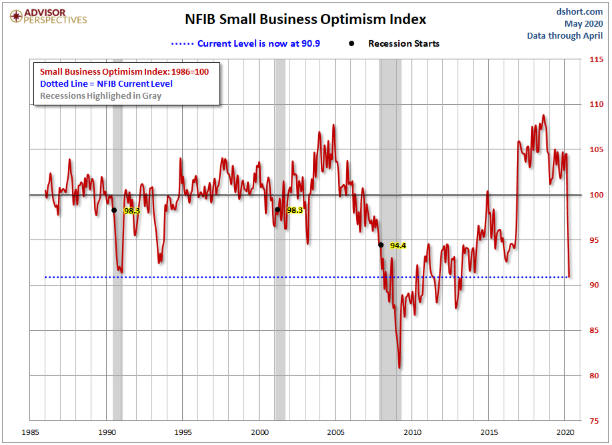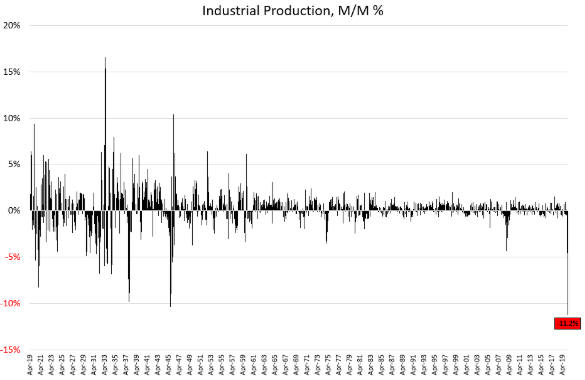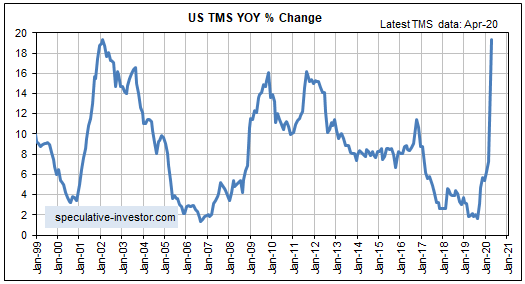[This blog post is an excerpt from a recent TSI commentary]
The year-over-year rate of growth in US True Money Supply (TMS), a.k.a. the US monetary inflation rate, has continued its journey “to da moon.” Based on the monthly monetary data for May-2020, it is now at 27% and still rising rapidly. The following chart shows that the money-supply growth surge engineered by “Mississippi Jay” Powell* now dwarfs the earlier efforts of “Easy Al” Greenspan and “Helicopter Ben” Bernanke.
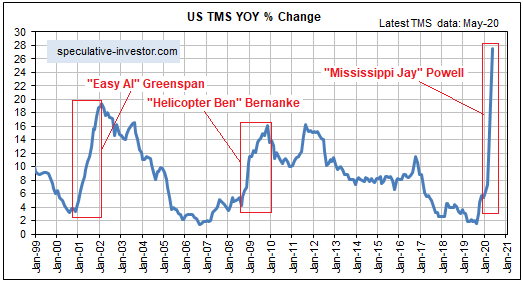
Anyone who thinks that this year’s monetary inflation moon-shot won’t lead to much higher prices for many things is kidding themselves. It has already fuelled the fastest 40% rise in the S&P500 Index in history, but unlike the other money-supply growth surges of the past 20 years the current episode also should lead to substantial gains in what most people think of as “inflation”. Not so much this year, because in the short-term there are counter-balancing forces such as an increasing desire to hold cash, but during 2021-2022.
Apart from its larger scale, there are three reasons that the money-supply growth surge engineered by “Mississippi Jay” should lead to much higher “price inflation”** than the money-supply growth surges engineered by his predecessors. The first is that although the Fed is still buying US government debt via Primary Dealers as opposed to directly from the government, it is crystal clear that the Fed is monetising the US government’s deficit. That’s why the Federal government is no longer even pretending to be concerned about the level of its spending and indebtedness. In effect, MMT (Modern Monetary Theory) is now being implemented in the US.
MMT is based on the ridiculous idea that there should be no upper limit on government spending/borrowing, facilitated via the creation of new money, as long as the CPI’s growth rate is below a certain level. It completely ignores all effects of monetary inflation apart from the most superficial. It also ignores the reality that government spending tends to be counterproductive because it is driven by political considerations and not market forces.
The good thing about MMT is that it should short-circuit the boom-bust cycle, in effect almost skipping the boom and going directly to an inflationary bust. This is because it lays bare the crudeness of the central bank’s monetary machinations. No longer is the central bank (incorrectly) perceived as finely tuning interest rates to keep the economy on an even keel. Under MMT it is seen to be pumping out whatever amount of new money the government demands.
The boom associated with this year’s monetary inflation moon-shot began in April and probably will end within the next six months. Actually, it might have ended already.
The second reason to think that this year’s money-supply growth surge will be followed by substantial “price inflation” is that the lockdowns of the past few months have damaged supply chains. This, combined with the shift away from globalisation, will lead to reduced supply and/or less efficient production of goods.
The third reason is supply constraints on important commodities. Firstly, this year’s lockdowns caused the mining industry to delay expansion plans and cancel new developments. Secondly, in labour-intensive mining countries such as South Africa, the requirement to implement social distancing following the return to work has made and will continue to make the mines less efficient. Thirdly, many small-scale commodity producers that together account for a significant portion of total supply have been put out of business by the lockdowns. Fourthly, the “El Nino” weather event of 2020-2021 and the Grand Solar Minimum that should start becoming influential in 2021-2022 probably will result in extreme weather volatility, which potentially will disrupt the supply of important agricultural commodities during 2021-2022. Lastly, due to the virus-related lockdowns and associated economic pressures there is heightened risk of war in the Middle East, implying heightened risk of an oil supply shock.
In summary, the latest flood of new money created by central banks will be more widely perceived to be “inflationary” than the other ‘money floods’ of the past 20 years. In addition, the latest money flood has occurred near the start of a multi-year period during which the production of many commodities and manufactured goods will be hampered. A likely result is substantial “price inflation” during 2021-2022.
*“Mississippi Jay” is the nickname we’ve given to current Fed Chair Jerome (Jay) Powell. The name links Powell with John Law, the roguish Scotsman (is there any other kind?) who, while residing in France in the early-1700s, engineered the Mississippi Bubble via a scheme that involved creating an extraordinary amount of new currency.
**We don’t like the term “price inflation”, because there is no such thing as an economy-wide average price level and because at any given time some prices will be rising while others are falling. However, we use the term because it is generally understood to mean a rising cost of living for most people.
 Print This Post
Print This Post

